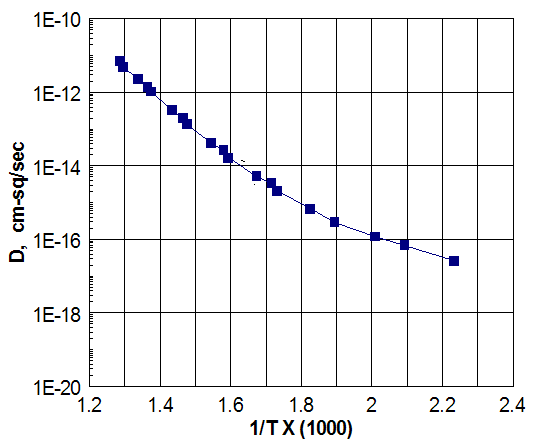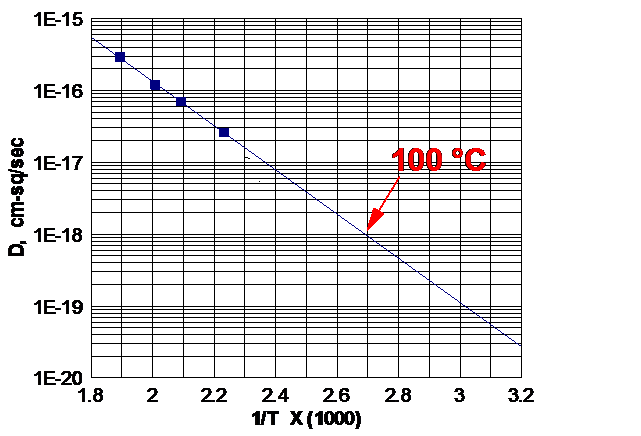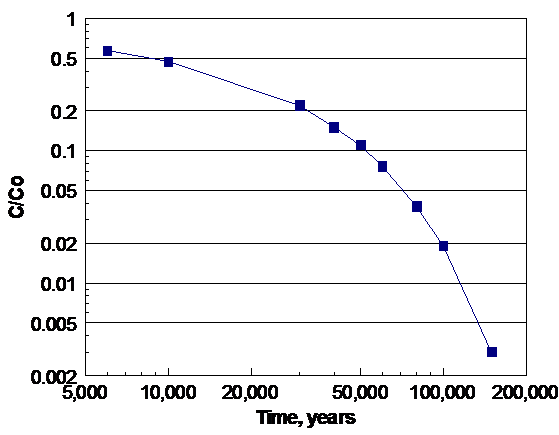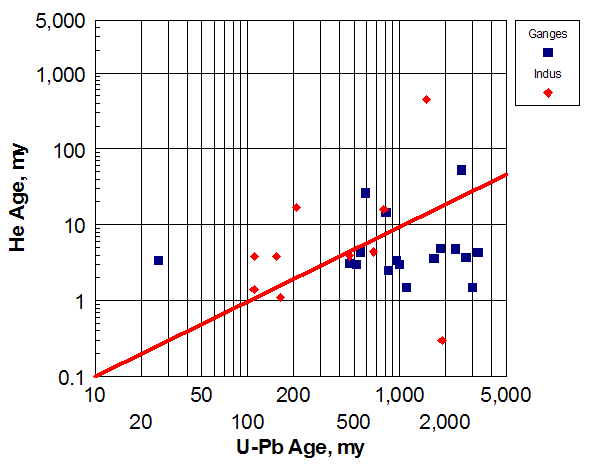Creation Science Rebuttals
Institute for Creation Research
Critique of the RATE Group’s Zircon-Helium Diffusion Project
by
Timothy K. Christman, Ph.D.,
Columbus, Ohio
Published 7 November 2005
Few areas of science have posed a greater challenge to Young-Earth Creationism than radiometric dating of rocks and minerals. These techniques, which have been in use for nearly a hundred years, show that rocks from the earth and moon, as well as some meteorites, are as old as 4.0 to 4.5 billion years. That observation is clearly at odds with the belief that world is only around 6000 years old. To counter the conclusions of radiometric dating creationists have formed the RATE (Radioisotopes and the Age of the Earth) Group. This team, supported by several creationist organizations, exists to disprove the validity of radiometric dating. RATE’s latest undertaking concerns some microscopic zircon crystals recovered from a well near Fenton Hill, NM. The argument, presented in a creationist journal[1] goes like this: The rock formation is radiometrically dated at about 1.5 billion years of age. The zircons contain uranium and thorium which have decayed to their daughter products including helium. Most of the radiogenic helium is still present in the zircon crystals. If the crystals were really 1.5 billion years old the helium should have all diffused out into the surrounding mineral formations. Thus, the crystals cannot really be 1.5 billion years old rather they are only a few thousand years old. Otherwise the helium would be gone. The RATE research includes some limited analyses of helium contents of some zircon crystals, some diffusion rate measurements and calculations to support their claims about the short time of the diffusion process. A general critique of this work by Dr. Kevin R. Henke appears elsewhere[2] and I will not repeat most of those issues here, beyond mentioning that there are some serious questions as to how RATE calculated the ratios of theoretical to actual residual helium contents in the zircons (their Q/Q0 values). Rather, I will discuss the ability of the RATE conclusions to predict what is observed in other studies of helium in zircon crystals.
Any valid scientific theory must have predictive power. The authors of the RATE zircon-helium study claim that their primary thesis, that the earth is only 6000 years old, is vindicated by their calculations of the expected residual helium levels in the Fenton Hill zircon crystals. They claim that their "theory" has predictive power because they can use it to correctly calculate the remaining helium levels in zircons from various depths (and temperatures) in the well. The question remains, can this theory accurately predict the radiogenic helium levels in zircon specimens from sites other than the Fenton Hill well? To answer this question, I will make some predictions based on RATE’s data and conclusions and then compare them with field observations.
First, one needs to consider why anyone is interested in the helium levels in zircon crystals. Natural zircons (ZrSiO4) often contain uranium and thorium which decay (through a series of steps) to lead and helium.[3] The ratios of uranium and thorium to the corresponding daughter product lead isotopes can be used to date the time of formation of the crystal, based on the known half-lives of the original uranium and thorium isotopes. In theory, the helium contents can also be used for dating the crystals, but generally are not because at elevated temperatures the helium will rapidly diffuse out. In recent years, researchers like Dr. Kenneth Farley of the California Institute of Technology and Dr. Peter Reiners of Yale University have used helium-based age measurements to determine something of the cooling history of the zircon crystals. The uranium/lead age gives the time of initial formation, while the helium age tells when the crystal cooled to a temperature at which the helium was essentially all retained. These techniques can also be applied to other minerals such as titanate and apatite. Farley and Reiners and have developed the sophisticated laboratory equipment needed to accurately analyze microscopic crystals for the different isotopes of concern.[4]
To make any predictions about diffusion of helium out of crystals, one needs a diffusion rate at the temperature of concern. Table II of the RATE study[5] presents diffusion rates for helium in the Fenton Hill zircons over a range of temperatures. That data is reproduced in Figure 1, below. The diffusion rates are plotted on semilog axes against the reciprocal of the temperature in degrees Kelvin. The result is a line with a negative slope, which is typical of the Arrhenius Law behavior of a thermally activated process. Note that at lower temperatures the line breaks into a shallower slope. That indicates a different diffusion activation energy and hence that a different diffusion process is rate controlling. While such behavior is more typical in polycrystals where grain boundary diffusion becomes rate controlling at lower temperatures, there is apparently some structural factor in these monocrystals that promotes low temperature diffusion. In any case, the low temperature diffusion rates are critical for this discussion. Figure 2 shows the diffusion rate data for the four lowest temperatures evaluated in that study (175, 205, 225 and 255EC). The data points definitely form a straight line. Extrapolating these data can be a little risky so I will not try to extend the trend line much farther than the range of abscissa values covered by the four existing data points. That extrapolation will extend nearly to a value of 0.00268 or about 100EC. The diffusion rate extrapolated to that temperature is approximately 1E-18 cm2/sec.
The next step of this analysis is to estimate the rate at which helium would diffuse out of a zircon crystal at 100EC. For that calculation I used the degassing formula that estimates the average helium level left in the crystal after some diffusion time. That formula is given as an infinite series of the following expression.[6]

Where CO = the original helium concentration, C = the average concentration at some time t, D = the diffusivity and R = the particle radius. To estimate the remaining helium levels at various times I calculated the first 20 terms of the series (higher order terms are so small as to be irrelevant to the total). Figure 3 shows, for various times, the predicted helium level, as a fraction of the original for zircon crystals of 30 micron radius and a diffusion rate of 1E-18 cm2/sec. That radius is typical of the zircons studied by the RATE group and others and the diffusion rate is extrapolated from their data. The figure shows that the helium concentration needs nearly 50,000 years to drop to approximately 0.1 times the original level, while nearly 100,000 years are needed for the residual level to reach 0.02 times the original.
Having made these predictions, the next step is to compare them with data from studies on zircons that are found at ambient temperatures and are not likely to have been at elevated temperature during the last 6000 years (RATE’s estimate of the age of the earth). There are several studies in the literature that report such data. The first was published by Reiners, Farley and Hickes[7]. In that work, zircon specimens were obtained from the Gold Butte formation in southeastern Nevada (near Lake Mead). That is an unusual formation which geologists interpret as having formed vertically about 1.5 billion years ago (roughly the same age as the Fenton Hill formation). About 15 million years ago this igneous rock mass was tilted on its side as the earth’s crust shifted, exposing rock that had previously been buried as deep as 15 km (about 9 miles). After the formation had tilted the deeper rock quickly cooled. The authors reasoned that the rock closest to the surface before tilting would have probably cooled sooner that the deeper rock. To estimate the time of cooling they measured the age as indicated by the uranium, thorium and helium contents for zircons from different locations along the now tilting rock formation. Keep in mind that the helium dating method gives the time at which the rock cooled to low temperature, not its total age. Their results indicated that the deepest rocks (near 15 km from the original ground surface) did not cool until about 15 million years ago, or about the time the vertical rock formation tilted and the lower level rock was brought to the surface where it could cool. Rock which had been at shallower depths before tilting (about 4 km or 2.4 miles) showed helium-based ages of over 160 million years. That stands to reason since rock closer to the surface would have cooled sooner than deeper rock. Reiners has demonstrated very similar results for helium based ages of crystals of the mineral titanate also extracted from various positions along the Gold Butte[8]. The zircons from the deepest section, prior to tilting, have helium contents only about 1 percent of the theoretical helium that should have formed during 1.5 billion years of radioactive decay. The helium level of the uppermost rocks is about 10 percent of the theoretical maximum. Those helium levels are hard to reconcile with RATE’s ideas about the age of the earth. According to RATE this rock formation is only about 6000 years old. How then could zircons from near the surface (at temperatures even lower than the 100EC I used for my diffusion calculation) have lost so much of their helium?
In a similar work, Reiners[9] reported the ages of zircons found in Missouri River sediments. He found that most of the zircons with uranium/lead ages greater than 1.2 billion years had helium-based ages less than 50 million years. Some had helium ages of only 50 - 70 million years. Reiners also reported that zircons from sediments in the Kamchatka region of Siberia showed helium-based ages less than ten percent of the uranium/lead ages.[10] Reiners’ colleague, Ian Campbell, conducted similar experiments on sediments from the Ganges and Indus Rivers of India[11] and found even more dramatic results with helium ages often less than one percent of the uranium/lead age. Figure 4, below, shows a plot of data from Campbell’s article, comparing the uranium/lead and helium ages of these sediments. The heavy line added to the plot represents a ratio of one percent. Thus, many of the zircons from these sediments have helium ages of less than one percent of the uranium/lead age as well as correspondingly low helium contents. The results of helium measurements from these detrital samples are significant because there is no conceivable scenario for those zircons to have been exposed to elevated temperature (>100EC) during the last 6000 years. These sediments must have been eroded from near the surface in the mountains of northern India. To have eroded during the last 6000 years they could not have been at great depths beneath the surface. Thus, they could not have been exposed to elevated temperatures during the last 6000 years. This leaves the question of how the zircons that have certainly been at low temperatures during a time span that exceeds the creationist estimate of the age of the earth could have lost most of their helium. There simply has not been enough time for the helium to have diffused out. Clearly the real answer to this question is that the zircons are millions or billions of years old and that most of the helium diffused out during a time when the crystals were exposed to higher temperatures that corresponded to much faster diffusion rates. The trouble is that RATE’s idea of the age of the earth does not admit enough time for that to have happened.
The RATE study claims to have correctly predicted the helium contents of zircons from various depths (and temperatures) in the Fenton Hill well. That may or may not be the case, depending on the validity of the residual helium calculations in that study. In any case, the RATE "theory" totally fails to predict the helium contents of other zircons found at different sites in Asia and North America. The zircons have clearly lost more helium than could be explained by 6000 years of diffusion at low temperatures.
In the interest of responsible science, the RATE team members should carefully consider why their results are so different from everyone else’s. In particular they should have more carefully evaluated the possibility that helium from external sources got into their zircons and added to the radiogenic helium formed by uranium and thorium decay. They should have also considered the very complex thermal and geologic history of a site so close to a volcano[12]. They should have examined whether their specimen preparation technique might have induced some unusual behavior in the zircon crystals that accelerated the diffusion rate measurements. Finally, they should have repeated their lower temperature (down to at least 100C) experiments with helium in the zircons from the Fenton Hill well to show that they had reproducible results. Real science needs to be duplicated to prove its validity. RATE certainly has no grounds to declare the entire science of radiometric dating to be invalid based on a study that apparently involved only two published diffusion tests (only one of which actually showed the low temperature fast diffusion rates essential to their "theory"). In short, RATE needs to do a better job of explaining their results if they want to be taken seriously by mainstream scientists.
I thank Dr. Kevin R, Henke, University of Kentucky, for his critical review of this paper.

FIGURE 1. HELIUM DIFFUSION RATE DATA IN ZIRCON FROM REF. 1.

FIGURE 2. LOW TEMPERATURE DIFFUSION RATE DATA FROM REF. 1.

FIGURE 3. PREDICTED RATIO OF RESIDUAL TO ORIGINAL HELIUM LEVEL VS. TIME, FOR 30 Fm ZIRCON CRYSTALS AT 100EC

FIGURE 4. COMPARISON OF URANIUM/LEAD AGES WITH HELIUM AGES OF ZIRCONS FROM GANGES AND INDUS RIVER SEDIMENTS (FROM CAMPBELL, REF 10).
[1]Humphreys, D.R., et al, Helium Diffusion Age of 6000 Years Supports Accelerated Nuclear Decay, Creation Research Science Quarterly, Vol 41, (1), June 2004
[2]Henke, K.R., Young-Earth Creationist Helium Diffusion Dates, Fallacies Based on Bad Assumptions and Questionable Data, 2005 http://www.talkorigins.org/faqs/helium/zircons.html
[3] 238U forms 206Pb and eight helium atoms, 235U forms 207Pb and seven helium atoms, 232Th forms 208Pb and six helium atoms.
[4] It was Farley’s laboratory to which the RATE group initially submitted their zircons for analysis, using a front company to hide their true identity.
[5] Humphreys, ibid.
[6]Glicksman, Martin. E. Diffusion in Solids, Field Theory: Solid State Principles and Applications, Wiley and Sons, 2000, pages 101-102.
[7]Reiners, P.W., Farley, K.A., and Hickes, A.J., Thermochronometry of Zircon, Initial Results for Fish Canyon Tuff and Gold Butte, Nevada, Tectonophysics, V. 349, 2002, pages 297-308.
[8]Reiners, P.W., U-Th/He Chronometry Experiences a Renaissance , Eos, Vol 83, 2002, pages 21-27.
[9]Reiners, P.W., 2005, Zircon (U-Th)/He Thermochronometry, in Reiners, P.W. and Ehlers, T.A. (Eds.), Thermochronology, Reviews in Mineralogy and Geochemistry, v. 58, due out October 2005.
[10] Reiners, P.W. et al (U-Th)/(He-Pb) Double Dating of Detrital Zircons, American Journal of Science,Vol 305, April 2005, pages 259-311.
[11]Campbell, I.H. et al, He-Pb Double Dating of Detrital Zircons from the Ganges and Indus Rivers: Implications for Quantifying Sediment Recycling and Provenance Studies, Earth and Planetary Science Letters, 237(2005) 402-432.
[12]The Fenton Hill site lies only a short distance from the Valles Caldera, the remnants of one of the most massive volcanic systems in North America. The well was developed for geothermal energy experiments.
Link to more Answers in Genesis Rebuttals
Old Earth Creation Science Articles
To learn more
about old earth creationism, see
Old Earth Belief,
or check out the article
Can You Be A
Christian and Believe in an Old Earth?
Feel free to check out more of this website. Our goal is to
provide rebuttals to the bad science behind young earth creationism,
and honor God by properly presenting His creation.
